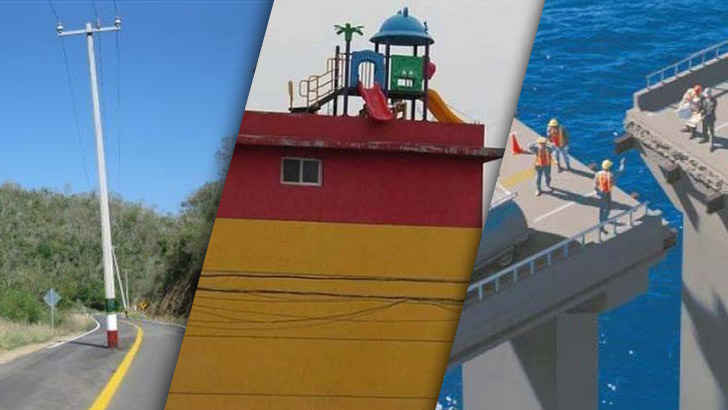TRENDING
Fastest Shrinking Cities In The U.S.
Published
3 years agoon
Every decade in the United States, a census is taken to figure out the population levels across the country. Those numbers can show which cities and states have been hit harder than others due to economic problems, and which have experienced population booms in recent years. As with most things in life, the popularity of some of the most famous cities in the United States changes with the times.

Not every state has a New York City or San Francisco that can bring thousands of new residents every year. Economic and social issues have been major reasons for people looking to leave their cities in the past, and those problems haven’t entirely disappeared. These cities are the fastest shrinking in each state across the USA.
Selma, Alabama

The city of Selma, Alabama, is ingrained in the history of the United States due to its involvement in the civil rights movement and the Selma Voting Rights Movement. Despite being one of the most famous cities in Alabama, it seems that people are skipping town fast. From 2010 to 2018, the population of Selma has fallen by 13.8%. It seems that people have been leaving the city ever since the 1960s, and according to the 2018 census, the population dropped from 20,756 in 2010 to 17,886.
Cordele, Georgia

People just don’t seem to want to stick around Cordele, Georgia. The city has been struggling to keep people for years, and the government has even passed a law to try and put a stop to Cordele’s decline. In 2000 the population of Cordele was 11,608, and in 2018 that number was 10,638. Cordele is losing people year after year, and there are suggestions that taxes will be lowered to try and bring more people to the Georgia city.
Honolulu, Hawaii

Hawaii continues to experience a population decrease, with Honolulu feeling it more than most. The Hawaiian city lost 11.1% of its population according to the 2018 census, with people looking to find another place to call home. It’s thought the main reason why so many people are leaving Hawaii’s famous city is due to the living costs in Honolulu. The estimated living cost in Honolulu is thought to be almost 30% higher than living in Austin, Texas. With cheaper alternatives elsewhere in the United States, it’s easy to see why people are leaving Honolulu behind.
Newport, Kentucky

For generations, Newport, Kentucky, has been the urban center for the northern region of the state. Unfortunately for the people of Newport, the population has been declining ever since the 1950s. Newport might be a small city, but it has been a big part of Kentucky life for many years. People have been leaving the city since the ‘50s, but more recently, they left in their droves. Newport experienced a drop in population by 10% between 2000 and 2010, with a further 1.7% reduction in the 2018 census.
Shreveport, Louisiana

Recent censuses have shown that Shreveport, Louisiana, is steadily losing residents every year. Since 2010 Shreveport has seen its population shrink by 5.2%, with no suggestions that this trend won’t continue in the future. While many cities are trying everything they can to increase the number of people moving in, Shreveport is hesitant to do anything. The city’s mayor wasn’t ready to do anything to change the trend until further data was collected. While more information is always useful, there is also a need to act to safeguard the city’s future to avoid it becoming a ghost town.
Baltimore, Maryland

Although it might be one of the most recognizable cities in the United States, Baltimore has seen a consistent decline in population since the 1950s. Approximately 1.2% of the city’s population left between 2018 and 2019, meaning around 7,200 people backed their bags and didn’t look back. That number is part of a broader problem for Baltimore, with an estimated 3% population decrease since 2000. Considering the overall population figures across the United States have increased since 2000, it’s a worrying trend for Baltimore to see people leave year after year.
Ocean City, New Jersey

The people who live in Ocean City, New Jersey, cannot wait to leave. The city thrives on its tourism, but its permanent residents have been looking for other places to live since 2000. Between 2000 and 2010, 23.9% of Ocean City’s residents decided to find somewhere else to live, and that has continued over the last decade. The population has dropped a further 5.6% since 2010, with the cost of living the most likely reason for people finding new homes. New Jersey’s house prices are astronomical, and people from across the state are leaving for cheaper locations.
Flint, Michigan

The much-documented water crisis in Flint, Michigan, has seen the city become one of the poorest in the United States. With little hope for the future, people are leaving in their droves to try and find better lives for themselves outside of Flint. General Motors was once the reason Flint had a bustling population, but the downsizing of its operations reduced the number of available jobs. In 1960 Flint’s population was 196,000, but by 2018, that number had shrunk to 95,943, meaning the city has lost over half of its population in that time.
St. Louis, Missouri

St. Louis, Missouri, was once in the top ten largest cities across the entire United States. That was in the past, though, as St. Louis is now ranked the 64th largest city in the country. The Missouri city was once booming, but now its numbers are steadily declining as people look to find somewhere better to live. St. Louis has had civic issues and leadership problems, leading to people fleeing the city, with 64% of its residents leaving since the 1950s. Since 2010, St. Louis has experienced a fall in its population by 5%.
Goldsboro, North Carolina

We don’t blame anyone who lived in Goldsboro for trying to leave after two hydrogen bombs were dropped on the city in the 1960s. Fortunately, neither detonated, and while one was retrieved, the other has not. There is a threat that the bomb could go off, which is enough to encourage plenty of people to leave the city since the 1960s. In 2013, residents learned that three of the four switches that prevented the detonation of the device from going off failed. With such a potential risk, 6% of Goldsboro’s population has decided sticking around isn’t for them.
Youngstown, Ohio

Like many cities that relied on the steel industry, Youngstown, Ohio, has recorded a decline in residents over the years. Back in the 1950s the city had a booming population of 168,000, but since then, the numbers have been steadily dwindling. In 2018 the census estimated there were now just 64,958 residents living in the city, a 3% decrease from the figures in 2017. With a lack of jobs giving people a comfortable living wage, residents are seeking out new locations to restart their lives.
Niagara Falls, New York

It might be home to one of the most iconic attractions in the United States, but Niagara Falls has experienced a steady decline in residents. Much like the gushing waters that fall from the Niagara River, the population of Niagara Falls is in freefall. The city has struggled to hold onto its city status in recent years, and in 2010 Niagara Falls had lost more than half of its population since the ‘50s. The 2018 census estimates Niagara Falls lost a further 4.1% of its residents, with the decline of the heavy industry likely to be the main reason why.
Johnstown, Pennsylvania

In the 1930s and ‘20s, Johnstown, Pennsylvania, was booming with over 65,000 residents. The bustling steel and coal industries helped to power this town throughout much of its history, but the times have changed. Those industries are no longer what they once were, and Johnstown has seen its population reduced to just 19,447 according to the 2018 census. Much of Pennsylvania has struggled with the decline of the steel industry, with Pittsburgh losing around 50% of its residents since the 1950s.
Baker City, Oregon

More and more people are flocking to Oregon, making it the ninth-fastest growing state in the country. The cities in Oregon are proving to be a hotspot for people to move into, but the towns in the state aren’t proving to be so popular. There aren’t many places in Oregon losing residents, and the biggest decrease in the state was found in Baker City. This city lost 0.7% of its residents, with the citizens seeking out somewhere larger to call home.
Corcoran, California

While California as a state experienced an increase in population pretty much annually, in 2019, it seems like the increase actually slowed down. One reason why California’s population boom may have begun to slow is cities like Corcoran are actually showing decreases in residents. Corcoran’s population recently reported a drop in residents by 12.6%, sending the city’s population down to 21,676. High taxes in California could be why the population boom has begun to slow, although it could also be Corcoran’s slower pace of life that drives people away.
Spartanburg, South Carolina

South Carolina’s major cities are experiencing population increases, but Spartanburg bucks that trend. The city is the only one in South Carolina’s 20 most populated cities to experience a decline. In fact, since the 1970s, Spartanburg has experienced a loss of 15.5% of its population, while the other major cities in South Carolina rose by at least 9%. Some cities increased their population by as much as 50% during this time period, meaning Spartanburg is lagging behind. A recent $27 million pledge by the Tindall Corporation to expand its operations in Spartanburg could give the city the boost it needs.
Gladeview, Florida

Gladeview in Florida was once a part of Miami, but jurisdiction was given up during the Great Depression. From the moment Gladeview was cast aside by Miami, the population figures have been steadily declining. Every year it seems like Gladeview gets smaller, and the shrinking appears to have accelerated since the 1980s. The population of Gladeview during the 1980s was around 18,000, but in the 2010 census, it had shrunk to 11,535. If the trend continues, Gladeview will find itself with fewer than 10,000 residents in the near future.
Dyersburg, Tennessee

Dyersburg, Tennessee, experienced a shrink in its population by 4.4% since 2010, and a further 1.8% between 2000 and 2010. The city has found itself stuck in a trend of losing residents for years, and there hadn’t been any sign that it was going to stop until recently. In 2018 the Frazier Industrial Company opened a new manufacturing plant in Dyersburg, which created 120 jobs. It also brought over $17 million in investment into the city, which may help to give the city’s economy the kickstart it needs.
El Paso, Texas

While some cities around the United States are seeing their populations decline in recent years, Texas is experiencing a boom in popularity. The state’s population just continues to grow, proving that things really are bigger in Texas, even after all this time. There is plenty of space for towns and cities to expand in Texas, plus there are a lot of opportunities for jobs, so people continue flocking to the state. Even though El Paso is seeing many of its residents leave, there are more people arriving than departing, giving the city a population increase of 5.2%.
Lawton, Oklahoma

Many years ago, Lawton was once the third-largest city in Oklahoma. Times have changed, and Lawton has slowly been losing citizens to other areas in the state and across the country. The city annexed Fort Sill in the hopes that it would bring the vibrancy back to life in Lawton, but that couldn’t change the city’s fortunes. Annexing Fort Sill did bring a temporary increase in population according to the 2010 census, but in 2018 there was a 4.1% reduction in Lawton’s residents.
Portsmouth, Virginia

Virginia has been doing its best to encourage people to move into the state. Despite attempting to bring people in, Virginia hasn’t prevented people from heading out of state to seek pastures new. One of the biggest cities in Virginia is Portsmouth, and since the 1960s there has been a continued decline in its population. In 1960 the population was 114,773, but since then, the figure has dipped below 100,000. The 2018 census estimated there were 94,632 people living in Portsmouth, Virginia, giving the city a 17% decrease of residents since the 1960s.
Douglas, Arizona

Although the state of Arizona is experiencing a population boom, not every city is appealing to new residents. Douglas, Arizona, had a population of 17,378 in the 2010 census, but in the 2018 census, the population had shrunk to 15,978. Some believe Douglas’ crime rates to be a contributing factor in why so many people are leaving the city, but it seems like people are just heading to the bigger cities. Phoenix experienced a population increase of 14.8% during the same period, so it appears people in Arizona are searching for a taste of city living.
Pittsfield, Massachusetts

When the jobs in a city disappear, it’s typically only a matter of time before the people follow in search of better fortunes. Pittsfield, Massachusetts, was once a thriving city thanks to General Electric’s presence, but when the company decided to leave during the 1980s, people started leaving. Since General Electric left Pittsfield, the city has experienced a 26.5% decline in population as employment opportunities were found elsewhere. Pittsfield lost an estimated 7,000 residents between 2010 and 2018, but with General Dynamics and Berkshire Health Systems offering employment, the city could rise once again in the future.
Gary, Indiana

Gary, Indiana, is really struggling to maintain its population levels due to a declining job market. The city was built on the manufacturing industry in years gone by, but today companies around the city have been shut down. The declining steel industry has also impacted the fortunes of the people living in Gary, and there has been a steady decline in residents since 1960. In the 2010 census, Gary lost an estimated 21% of its residents and a further 6% in 2018.
Norwich, Connecticut

Several of Connecticut’s cities have experienced shrinking populations in recent years, but none saw as many people leave as Norwich. This city lost an estimated 3% of its population, judging by the 2018 census. Norwich had actually experienced a population boom of 12.1% before this loss, and overall population figures have been declining since the 1960s. Both Hartford and New Haven also experienced population decreases, but Norwich lost the most. Norwich is now experiencing job growth thanks to submarine manufacturer Electric Boat, which is likely to see the population increase again over time.
Jackson, Mississippi

Mississippi is seeing people leave the state across many towns and cities as people are finding other parts of the country more attractive to live in. Some believe the state’s lack of employment growth and fewer leisure choices are forcing people to reconsider where they call home. The unemployment rate in Mississippi is higher than the national average, and Jackson is one of the cities struggling the most. Jackson’s population has shrunk by 5.2% since 2010 as people search for a better quality of life elsewhere.
Lovelock, Nevada

Most cities and towns in Nevada actually experienced an increase in their populations, so it’s the small town of Lovelock that saw the largest decrease in residents. The town saw 17.5% of its population leave for good, but that only amounts to around 395 people. The rest of Nevada appears to be thriving, and even Las Vegas experienced a huge population increase of 10%. It’s not all bad news for Lovelock, though, with a federal grant of $600,000 given to the town to freshen up its outside spaces to attract new residents.
Pine Bluff, Arkansas

Following the Second World War, Pine Bluff, Arkansas, experienced a boom like never before in the city’s history. There was a steady influx of people to Pine Bluff after 1945, and the city reached its largest population during the 1970s of 57,400. Since then, the Arkansas city has suffered a steady decline in population, with the advancement of technology thought to be a significant contributing factor. The city is one of the lowest-paid in the United States, and people are leaving to find better-paid employment elsewhere. Today the population of Pine Bluff is estimated to be around 42,000.
North Platte, Nebraska

North Platte, Nebraska, is just one of several cities and towns across Lincoln County that has seen its population shrink in recent times. Resident numbers across the county are decreasing, but North Platte saw an exodus of 3.7% of its residents since 2010. It’s thought economic issues are the main reason for people looking for a new place to live, and it’s something the city is aware of. North Platte’s Area Chamber and Development Corporation explained the city has “some work to do,” in getting its population and economy growing once again.
Sterling, Colorado

Colorado is another state that has seen its overall population boom. Despite many cities across Colorado increasing their population, not every major spot in the state did. Sterling, Colorado, seems to be the exception in the state, and while every other city recorded a population boom, Sterling’s residents went looking for somewhere else to call home. The worry for Sterling is that it continues to lose more people following a 7.9% decrease in recent years. Sterling is trying to attract new people to its streets, however, and in 2019 there was a slight job growth of 0.7%.
Wilmington, Delaware

The city of Wilmington, Delaware, has been experiencing a population decrease ever since the 2000s. Since the 2000s, Wilmington has lost around 2.8% of its residents, with a large portion of those being young people. Almost a quarter of the residents leaving Wilmington are aged between 18 and 34, but there is hope that not all young people are going to leave. The schools in Wilmington are very highly rated, meaning that parents could be choosing to move to the city to give their kids the best education possible.
Milwaukee, Wisconsin

Milwaukee might have an NBA franchise to call its own, but if people don’t have jobs, then they aren’t going to stick around for basketball games forever. Wisconsin is actually experiencing a population growth, but Milwaukee is not a part of that boom as it lost over 3,000 citizens since 2010. Ever since the 1960s, the city has been experiencing a population decrease, and 150,000 fewer people live there now. There is hope for the city, though, as there are plans to bring in more tech jobs so Milwaukee can compete better with Chicago and Indianapolis.
Rock Island, Illinois

Illinois has been struggling to keep people from moving away for many years, and even Chicago has recorded population drops in recent times. One city with a noticeable reduction in the number of people living there is Rock Island, which was once booming during the 1980s. Since then, the city has been slowly shrinking, and it recorded a 3.4% decrease in size in 2018 from 2010. People in Illinois have been moving out of the bigger cities and into small towns and cities for a different lifestyle.
Rutland, Vermont

Vermont hasn’t experienced a huge outflux of people, but it’s not exactly proving to be an attractive option for people either. The state’s population figures have pretty much stayed the same for many years, but there have been a few cities that have seen their numbers dwindle over time. Rutland has had a pretty tough time, and since 2010 it has seen a decrease in its population by 7.1%. Since the 1970s, Rutland has been losing people at a steady pace, with over 20% of the population finding somewhere else to call home.
Clinton, Iowa

Ever since the 1970s, Clinton, Iowa, has witnessed a decline in its population. The small city had a population of 34,719 people back in the ‘70s, but today the figure is estimated to be around 25,000. It has been a slow decline for Clinton, but the recent drop of 6.3% is the steepest the city has experienced in 40 years. Clinton isn’t the only city in Iowa to be struggling with population decreases, with Camanche also experiencing a drop in recent years.
Charleston, West Virginia

West Virginia has been voted as one of the worst places to live in the United States, so it’s not a huge surprise that people are looking to leave for a better life. A report published in 2018 discovered that over 11,000 people left West Virginia in just a year. People are scrambling to leave, and Charleston is one of the worst-hit cities. Despite being the state capitol and hosting a ton of attractions, people just don’t want to stick around in Charleston any longer. Since 2010 Charleston has lost 8% of its residents.
Coffeyville, Kansas

A lot of the time, economic reasons are behind a town or city’s decline, which seems to be the case for Coffeyville, Kansas. All of Montgomery County is shrinking, with Coffeyville experiencing the largest decline after losing an estimated 9% of its population since 2010. Coffeyville was, until recently, the host of an Amazon warehouse which employed 10,000 people in the area. The giant employer removed itself from Coffeyville in 2014, causing thousands of job losses, which were compounded when another large employer, Southwire, also closed its doors.
Hoquiam, Washington

Washington has experienced some of the biggest growth in population as a state, with over a million new residents moving in since 2010. As so many people have moved in, it means the population of many cities and towns have received a boost, but not all. One city that has struggled to attract new residents, and keep hold of its existing ones, is Hoquiam. This city has seen its population drop since 2000 to 8,596, with employment opportunities the main reason for people leaving Hoquiam behind.
Bangor, Maine

There have been population drops across the state of Maine, and Bangor is one of the worst-hit. Residents in Maine have fled to other states in search of better job opportunities, with Bangor suffering the biggest shrink. Approximately 3.2% of Bangor’s residents have left for pastures new since 2010, primarily due to the decreased job market. Six of Bangor’s main paper mills have been forced to shut in recent years, meaning job losses for thousands across the city. Once the paper industry began to decline, it was only a matter of time before people went elsewhere looking for employment.
Fairmont, Minnesota

In recent times many people in Fairmont, Minnesota, have fallen on hard times. In March 2015, the city lost one of its big employers with Fairmont Foods closing, and then the city’s hospital began to have financial difficulties. In 2019 rent prices rose to 49% higher than the average income in Fairmont, meaning people were being priced out of living in the city. Taking everything into consideration, it’s not a huge surprise that Fairmont has lost 5.4% of its residents since 2010, with poverty on the rise.
Worland, Wyoming

The major cities in Wyoming are experiencing continued growth, but that is often at the expense of smaller cities and towns. One such town that has seen its population take a bit hit over the years is Worland. Ever since the 1960s, the population numbers in Worland have had big swings, but these days it is certainly decreasing. Most recently, Worland experienced a population loss of 7.5%, which translates roughly to only 400 residents. It may be a worrying trend, and one that the residents of Worland will hope isn’t maintained.
Anaconda, Montana

While it might have one of the most exciting names in the United States, Anaconda has seen its residents dwindle to fewer than 10,000. Anaconda was once a popular city, but by 2000, the population had shrunk so much it was reduced to a town. People continue to flee Anaconda, with the latest census indicating 1.2% of its population left since the last records were made. An environmental issue involving an arsenic spill led to residents requesting a better clean up, but it seems they didn’t get their wish, so they are packing up and leaving.
Claremont, New Hampshire

There aren’t many cities in New Hampshire to choose from, but the three most populated cities all saw an increase in the number of residents. Manchester, Concord, and Nashua enjoyed population booms, but Claremont cannot say the same. This small city lost an estimated 2.9% of the people living there, and it seems as though there are two main reasons why people left Claremont. The city reportedly has the highest property taxes in the state, while a median household income of 70% less than the state average. It appears that people simply cannot afford to live in Claremont.
Lordsburg, New Mexico

New Mexico has been struggling to attract new residents for generations, and Lordsburg appears to be the worst-hit. The economic troubles in New Mexico make it a much less attractive relocation destination for many Americans, who often choose its neighboring states first. The population of New Mexico has largely remained the same since 2010, but Lordsburg experienced a 13.2% decrease in its population since 2010. That decrease is an addition to the 17.2% decline in residents Lordsburg witnessed between 2000 and 2010.
Warwick, Rhode Island

Rhode Island’s population has always been small, but it made headlines in 2018 when it was revealed there weren’t enough citizens to warrant two House seats. A drive to increase the state’s population began shortly afterward, with the introduction of a bill offering $10,000 tax credits to new residents. One of the cities worst affected by the decrease in population was Warwick, which lost 2.2% of its residents since 2010. Between 2000 and 2010, Warwick also lost 3.7% of its population, and there aren’t many signs of recovery for this troubled city.
Hot Springs, South Dakota

Many people are looking to move as close to major cities as possible, which means smaller, more rural, towns like Hot Springs, South Dakota are struggling. There has been a drastic change in population numbers in Hot Springs since 2000, with the town losing 10% in 2010, and a further 5% in 2018. The reason for the reduction in residents is clear when you compare these numbers to the increase in population of South Dakota’s major cities. Those increases elsewhere led to Hot Springs having a population of just 3,500, putting its city status in danger.
Taylorsville, Utah

Just like Texas, Utah is also enjoying a population boom with people from all over the country looking to move there. There were no major cities or towns experiencing population decreases, with some places experiencing unprecedented booms. Every city and town with a population of more than 10,000 experienced a population boom except for Taylorsville which has seen a slight decrease since 2010.
Anchorage, Alaska

Alaska had a real drive to bring more people to the state in recent years, and according to the 2010 census, it worked. People were given financial incentives to move to Anchorage by the Alaskan government, and in 2010 the population boomed by 12%. That was ten years ago, and it seems as though the bubble has burst on life in Alaska, with the number of people leaving Anchorage on the increase. The population dipped by 0.1% according to the 2018 census, although in 2019, there were reports of people leaving in their droves.
Jamestown, North Dakota

North Dakota has proven to be one of the most popular states in the country, and 2017 was the first time in 15 years the state recorded a decline in its population. People have been flocking to North Dakota for over a decade, but Jamestown might be the reason why the state recorded its first population decline in 2017. Jamestown lost 1.3% of its population according to the 2018 census, which isn’t something new for the small city. The city in North Dakota has actually recorded declining population figures ever since the 1970s.
None in Idaho

While many of the cities across the United States are experiencing decreases in population, according to the 2018 census, there wasn’t a single city in Idaho. It seems that people are coming from all over the country to find a home in Idaho, and they aren’t just sticking to the cities. Every city in Idaho is growing, and even the towns dotted around the state are experiencing population increases. Idaho has been growing for many years, with Mountain Home being the perfect example. This small city has seen its population increase by over 80% since 1990.
More From Auto Overload
-


The Most Beautiful Women Of All Time – Ranked
-


Most Epic Construction Mishaps Ever
-


Most Disliked Movie Endings
-


Athletes Who Lost it All
-


Most Dominating NFL Players Of All Time
-


The Worst Neighbors In The World
-


Most Epic Wedding Dresses Of All Time
-


Money-Saving Hacks That Increase Your Wealth
-


Can You Guess These Athlete Nicknames?
-


Rare Historical Vietnam War Photos
-


The Highest Paid Newscasters On Television
-


The Most Memorable And Surprising Deals Made On Shark Tank

